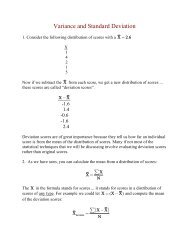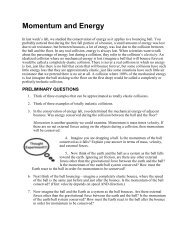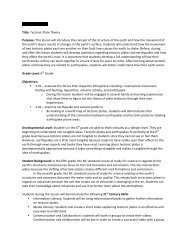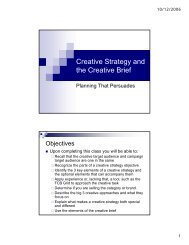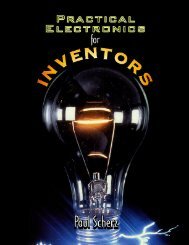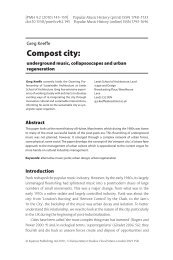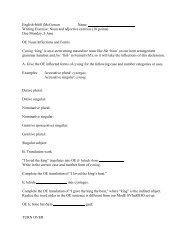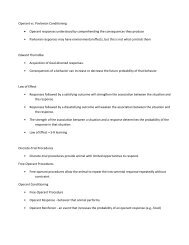Exam 3 - Answer Key
Exam 3 - Answer Key
Exam 3 - Answer Key
- No tags were found...
Create successful ePaper yourself
Turn your PDF publications into a flip-book with our unique Google optimized e-Paper software.
1. When the following equation is balanced, the coefficient of Al is __________.Al (s) + H 2 O (l) ? Al(OH) 3 (s) + H 2 (g)A) 1B) 2C) 4D) 5E) 3Al (s) + H 2 O (l) ? Al(OH) 3 (s) + H 2 (g)Al (s) + 3 H 2 O (l) ? Al(OH) 3 (s) + H 2 (g) balance OAl (s) + 3 H 2 O (l) ? Al(OH) 3 (s) + 3/2 H 2 (g) balance O and H2 Al (s) + 6 H 2 O (l) ? 2 Al(OH) 3 (s) + 3 H 2 (g) eliminate fraction2. When the following equation is balanced, the coefficient of O 2 is __________.C 2 H 4 O + O 2 ? CO 2 + H 2 OA) 2B) 1C) 5D) 3E) 4C 2 H 4 O + O 2 ? 2 CO 2 + H 2 O balance CC 2 H 4 O + O 2 ? 2 CO 2 + 2 H 2 O balance C & HC 2 H 4 O + 5/2 O 2 ? 2 CO 2 + 2 H 2 O balance C, H & O2 C 2 H 4 O + 5 O 2 ? 4 CO 2 + 4 H 2 O eliminate fraction3. Of the following compounds, which one will form something other than carbon dioxide and water uponcombustion in air?A) C 5 H 5 NB) CH 4C) CH 3 OCH 3D) C 2 H 6E) C 32 H 44 O 9C 5 H 5 N contains an element other than C, H & O. Something must happen withthe N, therefore something other than CO 2 and H 2 O must be formed.4. Predict the product in the combination reaction below.Al + N 2 ? __________A) Al 3 N 2B) AlNC) Al 2 N 3D) Al 3 NE) AlN 2Al always forms 3+ cations and the nitride anion is 3-. Therefore they must formin a 1:1 ratio: AlN5. The formula weight of ammonium sulfate ((NH 4 ) 2 SO 4 ) is __________ amu.A) 116B) 100C) 264D) 118E) 132Note there are 2 ammonium ions, thus 2 N and 8 H.2 N 2 x 14 = 288 H 8 x 1 = 81 S 1 x 32 = 324 O 4 x 16 = 641326. The mass % of H in methane (CH 4 ) is __________.A) 92.26B) 25.13C) 7.743D) 4.032E) 74.87mass H4 gmass % H = x 100% = x 100% = 25%total mass 16 g
7. One mole of __________ contains the largest number of atoms.A) Al 2 (SO 4 ) 3B) Cl 2C) C 10 H 8D) S 8E) Na 3 PO 42 (Al) + 3 (S) + 12 (O) = 17 atoms2 (Cl) = 2 atoms10 (C) + 8 (H) = 18 atoms8 (S) = 8 atoms3 (Na) + 1 (P) + 4 (O) = 8 atoms8. There are __________ mol of carbon atoms in 4 mol of dimethylsulfoxide (C 2 H 6 SO).A) 6B) 4C) 3D) 2E) 82 mol. C4 mol. C2HSO 6x = 8 mol. C1 mol. CHSO2 69. What is the empirical formula of a compound that contains 27.0% S, 13.4% O, and 59.6% Cl by mass?A) SOCl 2B) SOClC) S 2 OClD) SO 2 ClE) ClSO 4S: 27g / 32 g/mol ~ 1O: 13.4 g / 16 g/mol. ~ 1Cl: 59.6 g / 35.5 g/mol. ~ 2therefore - SOCl 2more accurately:S: 27g / 32 g/mol = 0.84, 0.84 / 0.84 = 1O: 13.4 g / 16 g/mol. = 0.84, 0.84 / 0.84 = 1Cl: 59.6 g / 35.5 g/mol. = 1.64, 1.64 / 0.84 = 2therefore - SOCl 210. A 3.82-g sample of Mg 3 N 2 (MW=100.9 g/mol.) was combined with 7.73 g of water (MW=18.02 g/mol.) togive 3.60 g MgO (MW=40.30 g/mol.). What is the percent yield in the reaction?Mg 3 N 2 + 3 H 2 O ? 2NH 3 + 3MgOA) 94.5%B) 46.6%C) 78.8%D) 99.9%E) 49.4%1 mol. Mg N 3 mol. MgO 40.3 g MgO3 23.82 g Mg3N 2x x x = 4.58 g MgO100.9 g Mg3N2 1 mol. Mg3N21 mol. MgO1 mol. H O 3 mol. MgO 40.3 g MgO27.73 g H2O x x x = 17.3 g MgO100.9 g H2O 3 mol. H2O 1 mol. MgOThus Mg 3 N 2 is the limiting reagent.3.60 g% yield = x 100% = 78.8%4.58 g11. What is the maximum mass of SO 3 (MW=80.06 g/mol.) that can be produced by the reaction of 1.0 g ofS (MW=32.07 g/mol.) with 1.0 g of O 2 (MW=32.00 g/mol.) via the equation below?2 S (s) + 3 O 2 (g) ? 2 SO 3 (g)A) 0.27 gB) 3.8 gC) 1.7 gD) 2.0 gE) 2.5 gSince we start with equal masses of S and O 2 , and they have the same MW, thenO 2 must be the limiting reactant since the reaction requires 3 moles O 2 per mole S.1 mol. O22 mol. SO3 80.06 g SO31.0 g O2x x x = 1.7 g SO332.0 g O 3 mol. O 1 mol. SO2 2 312. What is the solvent in an aqueous solution of sodium chloride?a) sodiumb) chlorinec) waterd) NaCle) ethanol
13. A strong electrolyte is one that __________ completely in solution.A) decomposesB) disappearsC) ionizesD) reactsE) dissolves14. The net ionic equation for the reaction between aqueous solutions of HCl and KOH is __________.A) H + + OH - ? H 2 OHCl + KOH ? H 2 O + KCl all but H 2 O ionize, giving:B) HCl + KOH ? H 2 O + K + + Cl -H + + Cl - + K + + OH - ? H 2 O + K + + Cl -C) HCl + K + + OH - ? H 2 O + KClhowever, K + and Cl - are spectator ions and areD) H + + Cl - + K + + OH - ? H 2 O + K + + Cl - removed, leaving:E) HCl + OH - ? H 2 O + Cl - H + + OH - ? H O 215. Which ion(s) is/are spectator ions in the reaction of BaI 2 and K 2 SO 4 ?A) K + onlyBaIB) Ba 2+ 2 (aq) + K 2 SO 4 (aq) ? BaSO 2 (s)+ 2KI (aq) all species ionize, giving:onlyC) Ba 2+ 2-Ba 2+ + 2I - + 2K + 2-+ SO 4 ? BaSO 2 (s)+ 2K + + 2I -and SO 4D) K + and I -K + and I - are present on both sides of the equation and must thereforeE) SO 2- 4 and I - be the spectator ions.16. The balanced net ionic equation for the reaction of aqueous solutions of Li 2 CO 3 and CaCl 2 are mixed isA) Li 2 CO 3 (aq) + CaCl 2 (aq) ? 2LiCl (aq) + CaCO 3 (s)B) 2Li + (aq) + 2Cl - (aq) ? 2LiCl (aq)C) Li + (aq) + Cl - (aq) ? LiCl (aq)D) Ca 2+ (aq) + CO 3 2- (aq) ? CaCO 3 (s)E) 2Li + (aq) + CO 3 2- (aq) ? Li 2 CO 3 (aq)Equation A is the full equation, rewritten with allaqueous species ionized gives:2Li + (aq) + CO 3 2- (aq) + Ca 2+ (aq) + 2Cl - (aq) ?2Li + (aq) + 2Cl - (aq) + CaCO 3 (s)removing the spectator ions (Li + + 2Cl - ) leaves:Ca 2+ (aq) + CO 3 2- (aq) ? CaCO 3 (s)17. In which reaction does the oxidation number of oxygen increase:A) 2 SO 2 (g) + O 2 (g) ? 2 SO 3 (g)B) HCl (aq) + NaOH (aq) ? NaCl (aq) + H 2 O (l)C) Ba(NO 3 ) 2 (aq) + K 2 SO 4 (aq) ? BaSO 4 (s) + 2KNO 3 (aq)D) MgO (s) + H 2 O (l) ? Mg(OH) 2 (s)E) 2 H 2 O (l) ? 2 H 2 (g) + O 2 (g)O 2- + O 0 ? O 2-O 2- ? O 2-O 2- ? O 2-O 2- + O 2- ? O 2-O 2- ? O 0ox. number decreasedox. number unchangedox. number unchangedox. number unchangedox. number increased18. In which species does sulfur have the highest oxidation number?A) S 8 (elemental form of sulfur)B) K 2 SO 4C) H 2 SO 3D) H 2 SE) SO 2O.N. = 0 (by def'n elements have ox. # of 0)2(+1) + x + 4(-2) = 0, x = +62(+1) + x + 3(-2) = 0, x = +42(+1) + x = 0, x = -2x + 2(-2) = 0, x = +4
19. The net ionic equation for the dissolution of zinc metal in aqueous hydrobromic acid is __________.A) 2Zn (s) + 2H + (aq) ? 2Zn 2+ (aq) + H 2 (g)B) Zn (s) + 2Br - (aq) ? ZnBr 2 (aq)C) Zn (s) + 2HBr (aq) ? ZnBr 2 (s) + 2H + (aq)D) Zn (s) + 2HBr (aq) ? ZnBr 2 (aq) + 2H + (aq)E) Zn (s) + 2H + (aq) ? Zn 2+ (aq) + H 2 (g)The overall equation is:Zn (s) + 2HBr (aq) ? ZnBr 2 (aq) + H 2 (g)The ionic equation is:Zn+ 2H + + 2Br - ? Zn 2+ + 2Br - + H 2Removing the spectator ion (Br - ) leaves the net ionic eq.:Zn (s) + 2H + (aq) ? Zn 2+ (aq) + H 2 (g)20. Oxidation cannot occur without __________.A) waterB) acidC) airD) reductionE) oxygenIf one species gains electrons, another must be giving up (an equal numberof) electrons21. Which of the following is an oxidation-reduction reaction?A) H 2 CO3 (aq) + Ca(NO 3 ) 2 (aq) ? 2HNO 3 (aq) + CaCO 3 (s)B) Ba(C 2 H 3 O 2 ) 2 (aq) + Na 2 SO 4 (aq) ? BaSO 4 (s) + 2NaC 2 H 3 O 2 (aq)C) HCl (aq) + NaOH (aq) ? H 2 O (l) + NaCl (aq)D) AgNO 3 (aq) + HCl (aq) ? AgCl (s) + HNO 3 (aq)E) Cu (s) + 2AgNO 3 (aq) ? 2Ag (s) + Cu(NO 3 ) 2 (aq)Cu 0 ? Cu 2+ (oxidation)Ag + ? Ag 0 (reduction)In all other cases there is nochange in ox. no. Note that ionson reactant side reappear on theproduct side as well.22. Which one of the following is a correct expression for molarity?A) mol solute/kg solventB) mol solute/L solventC) mol solute/mL solventD) mol solute/L solutionE) mol solution/L solute23. How many grams of NaOH (MW = 40.0) are there in 500.0 mL of a 0.175 M NaOH solution?A) 114B) 3.50 x 10 3C) 14.01 L 0.175 mol. NaOH 40.0 g NaOHD) 3.50500 mL x x x = 3.50 g NaOHE) 2.19 x 10 -3 1000 mL 1 L 1 mol. NaOH24. There are __________ mol of bromide ions in 0.500 L of a 0.300 M solution of AlBr 3 .A) 0.150B) 0.0500C) 0.500D) 0.450E) 0.167Note that each mol. AlBr 3 gives 3 mol. Br - : AlBr 3 ? Al 3+ + 3Br -0.300 mol. AlBr 3 mol. Br1 L 1 mol. AlBr-3-0.500 L x x = 0.450 mol. Br3
25. A 0.100 M solution of __________ will contain the highest concentration of potassium ions.A) potassium phosphateB) potassium oxideC) potassium hypochloriteD) potassium iodideE) potassium hydrogen carbonateK 3 PO 4 (aq) ? 3K + (aq) + PO 4 3- (aq)K 2 O (aq) ? 2K + (aq) + O 2- (aq)KClO (aq) ? K + (aq) + ClO - (aq)KI (aq) ? K + (aq) + I - (aq)KHCO 3 (aq) ? K + (aq) + HCO 3 - (aq)26. What mass (g) of AgBr (MW=187.8) is formed when 35.5 mL of 0.184 M AgNO 3 is treated with anexcess of aqueous hydrobromic acid?A) 53.6B) 188C) 34.5D) 1.23E) 1.44AgNO 3 (aq) + HCl (aq) ? AgBr (s) + HNO 3 (aq)0.184 mol. AgNO 1 mol. AgBr 187.7 g AgBr1 L 1 mol. AgNO 1 mol. AgBr30.0355 L x x x = 1.23 g AgBr327. A 17.5 mL sample of a sulfuric acid (H 2 SO 4 ) solution required 29.6 mL of 0.250 M NaOH forneutralization. The concentration of sulfuric acid was __________ M.A) 4.73B) 0.211C) 0.846D) 3.38E) 0.423H 2 SO 4 (aq) + 2NaOH (aq) ? Na 2 SO 4 (aq) + 2H 2 O (l)0.250 mol. NaOH 1 mol. H2SO4-30.0296 L x x = 3.70 x 10 mol. HSO1 L 2 mol. NaOH-33.70 x 10 mol. H2SO 4 = 0.211 M H2 SO40.0175 L2 4



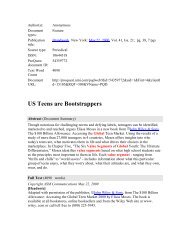

![Graduate Bulletin [PDF] - MFC home page - Appalachian State ...](https://img.yumpu.com/50706615/1/190x245/graduate-bulletin-pdf-mfc-home-page-appalachian-state-.jpg?quality=85)
